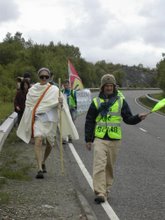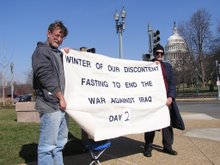Thursday, April 16, 2009
The deciders' price of US way of life
THURSDAY 16 APRIL 2009
Opinion
Iraq in Fragments
Sunday 12 April 2009
by: Dahr Jamail Visit article original @ Foreign Policy In Focus
Iraqi children, (L-R) Rebaz, 12, Omer, 7, Muhammad, 12, Hussein 7 and Imad, 11, who were injured during the Iraq war. (Photo: Reuters Pictures)
"[W]hat lengths men will go in order to carry out, to their extreme limit, the rites of a collective self-worship which fills them with a sense of righteousness and complacent satisfaction in the midst of the most shocking injustices and crimes." -Love and Living, by Thomas Merton
On Wednesday, March 25, Major General David Perkins of the U.S. military, referring to how often the U.S. military was being attacked in Iraq, told reporters in Baghdad, "Attacks are at their lowest since August 2003." Perkins added, "There were 1,250 attacks a week at the height of the violence; now sometimes there are less than 100 a week."
While his rhetoric made headlines in some U.S. mainstream media outlets, it was little consolation for the families of 28 Iraqis killed in attacks across Iraq the following day. Nor did it bring solace to the relatives of the 27 Iraqis slain in a March 23 suicide attack, or those who survived a bomb attack at a bus terminal in Baghdad on the same day that killed nine Iraqis.
Having recently returned from Iraq, I experienced living in Baghdad where people were dying violent deaths on a daily basis. Nearly every day of the month I spent there saw a car bomb attack somewhere in the capital city. Nearly every day the so-called Green Zone was mortared. Every day there were kidnappings. On good days there were four hours of electricity on the national grid, in a country now into its seventh year of being occupied by the U.S. military, and where there are now over 200,000 private contractors.
Upon returning home, I experienced the disconnect between that reality, lived by roughly 25 million Iraqis, and the surreal experience of living in the United States - where most media pretend the occupation of Iraq is either not happening, or uses the yardstick of decreased U.S. military personnel deaths in Iraq as a measure of success. In the words of Major General Perkins, "If you take a look at military deaths, which is an indicator of violence and lethality out there, U.S. combat deaths are at their lowest levels since the war began six years ago." But it's a less useful metric when one looks at the broader picture inside of Iraq: the ongoing daily slaughter of Iraqis, the near total lack of functional infrastructure, the fact that one in six Iraqis remains displaced from their homes, or that at least 1.2 million Iraqis have died as a result of the U.S.-led invasion and occupation of their country.
Seventy-two months of occupation, with over $607 billion spent on the war (by conservative estimates), has resulted in 2.2 million internally displaced Iraqis, 2.7 million refugees, 2,615 professors, scientists, and doctors killed in cold blood, and 338 dead journalists. Over $13 billion was misplaced by the current Iraqi government, and another $400 billion is required to rebuild the Iraqi infrastructure. Unemployment vacillates between 25-70%, depending on the month. There are 24 car bombs per month, 10,000 cases of cholera per year, 4,261 dead U.S. soldiers, and over 70,000 physically or psychologically wounded soldiers.
There 's no normal life in Baghdad. While it's accurate and technically correct to say there is less violence compared to 2006, when between 100 and 300 Iraqis were slaughtered on a daily basis, Iraq resembles a police state more than ever. U.S. patrols consisting of huge, lumbering mine-resistant vehicles rumble down streets congested with traffic. It's impossible to travel longer than five minutes without encountering an Iraqi military or police patrol - usually comprised of pickup trucks full of armed men, horns and/or sirens blaring. Begging women and children wander between cars at every intersection. U.S. military helicopters often rumble overhead, and the roar of fighter jets or transport planes is common. There's no talk of reparations for Iraqis for the death, destruction and chaos caused by the occupation.
Neighborhoods, segregated between Sunni and Shia largely as a result of the so-called "surge" strategy, provide a blatant view of the balkanization of Iraq. Neighborhoods of 300,000 people are completely surrounded by 10-foot high concrete blast walls, rendering normal life impossible. The fear of a resurgence of violence weighs heavy on Iraqis, as the current so-called lull in violence feels tenuous, unstable, and possibly fleeting. Nobody there can predict the future, and to hope for a sustained improvement in any aspect of life feels naive, even dangerous.
The title of the film "Iraq in Fragments" by James Longley, which was nominated for Best Documentary Oscar at the 2007 Academy Awards, best describes Iraq today. The country has been destroyed by decades of U.S. policy that has plagued Iraqis. Looking back only to 1980, we see the U.S. government supporting both Iraq and Iran during their horrible eight-year war. In 1991 we see George H. W. Bush's war against Iraq, and his, Bill Clinton's, and George W. Bush's oversight of 12-and-a-half years of genocidal economic sanctions that killed half a million Iraqi children. Today, under President Barack Obama, what is left of Iraq smolders in ruins, with no real end of the occupation in sight.
All of the recent talk of withdrawal from Iraq is empty rhetoric indeed to most Iraqis, who see the giant "enduring" U.S. military bases spread across their country, or the U.S. "embassy," the size of the Vatican City, in Baghdad. The gulf between the rhetoric of withdrawal and the reality on the ground spans the distance between Iraq and the United States, while the reality is pressed in the face of the Iraqi people each day the occupation continues.
Thursday, April 2, 2009
Remembering and Lamenting
As we journey the road to peace and justice, new expressions of the human heart and mind blossom. The Veterans for Peace have been creating memorials for US soldiers killed in Iraq over the recent years by placing religious symbols in open public grass areas like a military cemetery. These extensive memorials are impressive, stimulating a sense of the numbers of people who have been killed fighting for the nation. The loss of life can move the soul to appreciate the reality of war.
Now, we had the Iraq Memorial to Life. Here in Olympia Washington on the anniversary of the start of the Iraq war, we created a symbolic memorial to the Iraq persons killed since March 20, 2003. The memorials were in the form of markers which identified the person, often unknown by name, date of death, location. Each marker was handmade on authentic burial cloth shaped like a tombstone and laminated. These could be staked into the ground with a metal wire and spaced like a cemetery. We had nearly 4,000 markers, a mere fraction of the more than 90,000 deaths from the war which have been identified from newspapers, hospitals, or other documents in Iraq. The intention was to create one marker for each, but that was beyond our means at this time.
The Memorial did impress me and many others for its stark reminder that the war has been a horrendous experience. Each marker personalized a death, enabling the imagination to ruminate over a life cut short and relationships changed by the loss of a mother or father, son or daughter, grandparent, and friends.
I led meditations on both mornings of the Memorial. During the evening Vigil, the American Gandhi expressed the search for the real truth and the desire to express authentic love in this situation. This was a radical act here in the United States, which is still occupying and in some ways still at war with Iraq. I tried to put a face on the markers. Since the mainline media does not bring the faces to our attention because journalists are not going out to the Iraq communities, I went to the narrations of Kathy Kelly in her book Other Lands Have Dreams. Here are the first hand stories of the sick and dying during the sanctions which the UN says were killing 5,000 children each month. Kathy and other volunteers from Voices in the Wilderness were there and they were there when the invading troops arrived in Baghdad in 2003.
The Iraq Memorial to Life is now available to be transported and shown in other cities. We must be made aware of war and its consequences in this age of modern weapons which kill at the rate of 90 % civilians, a reversal of the 10 % killed at the turn of the 20Th Century. More information can be had by going to www.IraqMemorialToLife.org.
Having recently returned from Vietnam where I saw the continuing effects of Agent Orange and dioxin to the third generation, I felt very sensitive to the fact that our memorial was showing only a part of the death scenario. We did not highlight the sanctions effects between the 1991 Iraq war and the 2003 War. Further, we did not mention the effects of depleted uranium which will go on killing indefinitely.







